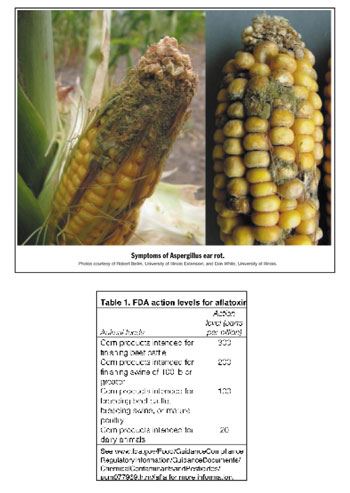Check Cornfields For Aspergillus Ear Rot
URBANA, ILL.
With high temperatures
and dry conditions
being prevalent during
this season’s corn grain-fill
period, the risk of Aspergillus
ear rot is high. Caused by the
fungus Aspergillus flavus, Aspergillus
ear rot is observed
as a yellowish-green mold growing on corn kernels.
Areas in fields that have insect- and birddamaged
ears may be affected more severely by
the disease. Aspergillus flavus produces a mycotoxin
known as aflatoxin, which is carcinogenic
to animals that consume
aflatoxin-contaminated grain. The U.S. Food
and Drug Administration (FDA) has established
specific action levels for aflatoxin-contaminated
corn grain, which are shown in Table 1.

Before harvesting a field, check for Aspergillus
ear rot. If it is observed in a field, and if the field
is covered by crop insurance, you must contact
your crop insurance agent before harvesting, as
the insurance will not cover losses due to aflatoxin
after grain is placed in storage. (See this
article by Dr. Gary Schnitkey, University of Illinois
professor of agricultural and consumer
economics)
Corn grain and silage samples to be tested for
aflatoxin can currently be sent to the Illinois Department
of Agriculture’s Centralia Animal Disease
Laboratory. However, the lab is scheduled
to close later this year, with services moving to
the Galesburg Animal Disease Laboratory.
Corn affected by Aspergillus ear rot should be
dried to below 15 percent moisture immediately
after harvest to prevent continued development
of mold and aflatoxin accumulation, and for
long-term storage moisture should be slightly
below 13 percent. Cleaning grain after harvest
may reduce the level of aflatoxin in that lot,
since broken and cracked kernels tend to have
higher levels of aflatoxin. If grain cleaning is
done, it is important that the screenings not be
fed to livestock, since aflatoxins are likely to be
more highly concentrated in them.
For more information about Aspergillus ear
rot, aflatoxin, and other corn ear molds and mycotoxins,
see the presentation by Dr. Charles
Woloshuk of Purdue University at the “Focus on
Corn” section of the Plant Management Network.
Δ
DR. CARL A. BRADLEY: Extension Plant Pathologist/
Assistant Professor, Department of Crop
Sciences, University of Illinois